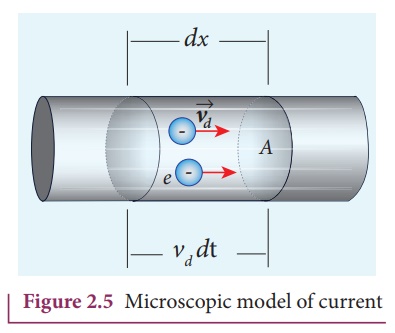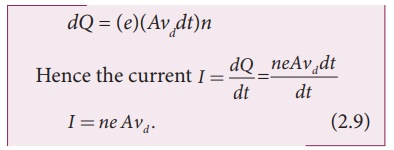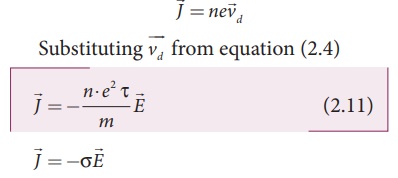Chapter: 12th Physics : Current Electricity
Microscopic model of current
Microscopic model of current
Consider a conductor with area of cross section A and an electric field ![]() applied from right to left. Suppose there are n electrons per unit volume in the conductor and assume that all the electrons move with the same drift velocity
applied from right to left. Suppose there are n electrons per unit volume in the conductor and assume that all the electrons move with the same drift velocity ![]() d as shown in Figure 2.5.
d as shown in Figure 2.5.

The drift velocity of the electrons = vd The electrons move through a distance dx within a small interval of dt

Since A is the area of cross section of the conductor, the electrons available in the volume of length dx is = volume ├Ś number per unit volume

Substituting for dx from equation (2.7) in (2.8)![]()
![]()
= (A vd dt ) n
Total charge in volume element dQ = (charge) ├Ś (number of electrons in the volume element)

Current density (J)
The current density ( J ) is defined as the current per unit area of cross section of the conductor.
J = I/A

The above expression is valid only when the direction of the current is perpendicular to the area A. In general, the current density is a vector quantity and it is given by

But conventionally, we take the direction of (conventional) current density as the direction of electric field. So the above equation becomes

where Žā = ne2Žä /m is called conductivity. The equation 2.12 is called microscopic form of ohmŌĆÖs law.
The inverse of conductivity is called resistivity (Žü) [Refer section 2.2.1].

EXAMPLE 2.3
A copper wire of cross-sectional area 0.5 mm2 carries a current of 0.2 A. If the free electron density of copper is 8.4 ├Ś 1028 m-3 then compute the drift velocity of free electrons.
Solution
The relation between drift velocity of electrons and current in a wire of cross-sectional area A is
vd = I/ ne A

vd = 0.03 x 10-3 m s-1
EXAMPLE 2.4
Determine the number of electrons flowing per second through a conductor, when a current of 32 A flows through it.
Solution
I = 32 A , t = 1 s
Charge of an electron, e = 1.6 ├Ś 10-19 C
The number of electrons flowing per second, n =?
I = q/t = ne/t
n = It/e
n = 32├Ś1 / 1 .6├Ś10ŌłÆ19 C
n = 20 ├Ś 1019 = 2 ├Ś 1020 electrons
Related Topics